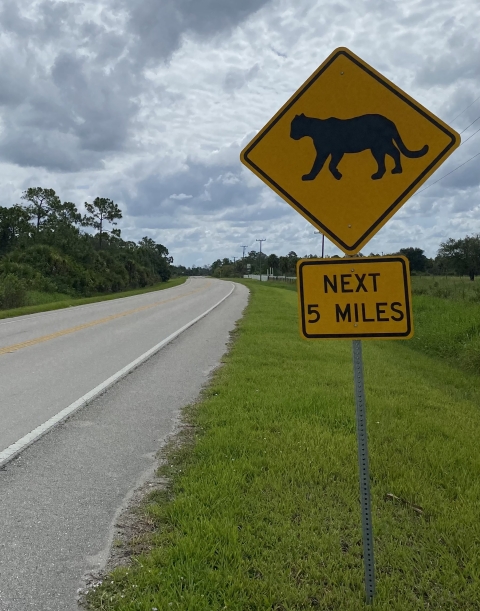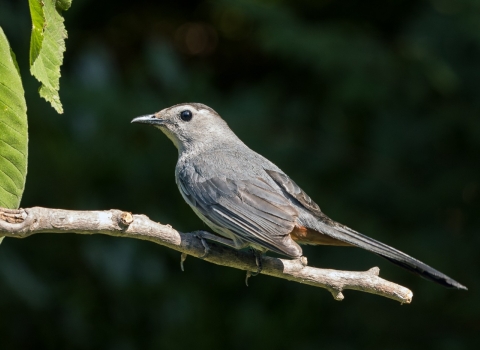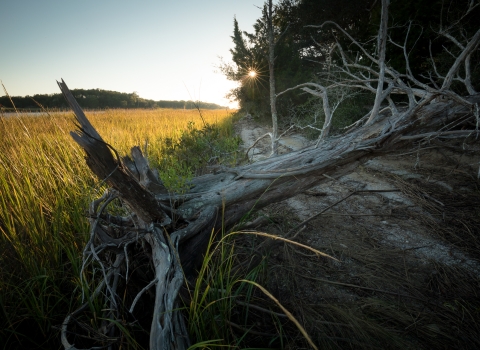Okeechobee, Florida – A decade ago, a coalition of local, state and federal conservation agencies stitched together grasslands, wetlands, pine forests, and cattle ranches across Central Florida into a vast, protected landscape that became the Everglades Headwaters National Wildlife Refuge and Conservation Area.
Local buy-in proved critical for the never-ending preservation of the working lands and public parks scattered across the ecologically rich Kissimmee River basin.
Today, the U.S. Fish and Wildlife Service, along with state and federal agencies and conservation nonprofits, is undertaking a bolder, critically important effort to create a larger conservation area conservation area
A conservation area or wildlife management area is a type of national wildlife refuge that consists primarily or entirely of conservation easements on private lands. These conservation easements support private landowner efforts to protect important habitat for fish and wildlife. There are 15 conservation areas and nine wildlife management areas in the National Wildlife Refuge System.
Learn more about conservation area that would stretch from Everglades Headwaters to Naples. Known, currently, as the Southwest Florida Fish & Wildlife Conservation Area, the landscape-scale project would mimic the patchwork of savannas and ranchlands of Everglades Headwaters, but on a grander scale.
The Service will soon hold public meetings to determine what lands to conserve, and where, across a study area that stretches from Lakeland past Lake Okeechobee to the Big Cypress National Preserve. A study area simply lays out the geographical parameters for future land protection. Land would only be acquired or protected from willing sellers. It is a wholly voluntary process.
The challenges to, and opportunities for, landscape, plant and animal protection are manifold. A conservation area would serve as a wildlife corridor wildlife corridor
To maintain healthy species populations and ecosystems, fish and wildlife need the freedom to move and migrate. As habitats and migration routes are affected by climate change and fragmented by roads, fences, energy development and other man-made barriers, wildlife struggle to reach necessary areas to feed, breed and find shelter. A wildlife corridor is a piece of undeveloped land connecting two habitats so wildlife can move safely between them.
Learn more about wildlife corridor for 74 federally threatened or endangered species, including Florida panthers, crested caracaras, and eastern indigo snakes. Plants and animals would be able to migrate inland, and away from, the ravages of sea level rise and climate change climate change
Climate change includes both global warming driven by human-induced emissions of greenhouse gases and the resulting large-scale shifts in weather patterns. Though there have been previous periods of climatic change, since the mid-20th century humans have had an unprecedented impact on Earth's climate system and caused change on a global scale.
Learn more about climate change to find sanctuary in Central Florida and, eventually, North Florida. And it would conserve land that otherwise would end up as subdivisions or strip malls. Look at a map: Orlando, Fort Myers, and Vero Beach are all growing rapidly toward the center of the Florida Peninsula -- prime real estate too for plants, animals, and outdoor-loving Floridians.
“It is a very ambitious plan because we need it and we’re running out of time,” said Kathleen Burchett, a Service supervisor in Florida who’s leading the conservation area charge. “What we’ve learned from previous landscape-scale efforts is that we must be bold and ambitious at the beginning. In order to achieve our conservation goals and objectives, the time is now.”
‘That piece of old Florida’
Bill Miller crunches along the newly burned prairie, a charred mosaic of black, brown and green grasses, sable palms, and oak hammocks. Baby grasshoppers flit about. A caracara alights on a singed palm. A coyote squeals in the distance. Two years ago, this land was cow pasture, a productive feeding ground for the Triple Diamond Ranch. Today it’s the Kissimmee Bend Unit of Everglades Headwaters. And, with private ranchlands to the east and south, and a state park to the north, it’s a critical piece of a conservation corridor puzzle.
“This is cattle country,” said Miller, the Service’s former project leader for Everglades Headwaters, a week or so after a prescribed burn prescribed burn
A prescribed burn is the controlled use of fire to restore wildlife habitat, reduce wildfire risk, or achieve other habitat management goals. We have been using prescribed burn techniques to improve species habitat since the 1930s.
Learn more about prescribed burn . “Ranchers do a great job of managing their land for cattle and wildlife. We wouldn’t have all these species here without them. The landscapes they manage for cattle are good for caracara, gopher tortoise, and other species too.”
It seems a bit incongruous that plodding, pooping bovines who unceasingly munch bluestem and other grasses co-exist nicely alongside federally threatened and endangered species. But many ranchers understand the big-picture ecological necessity of maintaining the natural prairie, with a variety of plants and shrubs, for cattle and other species. Deer, turkey, quail, turtles, black bears, Florida grasshopper sparrows, eastern indigo snakes, and myriad other species prefer the grassy savannah with trees for shelter and ephemeral ponds for water. This is also prime habitat for wide-ranging Florida panthers making their way northward from the Everglades. Barbed wire won’t unduly prevent animals from migrating, biologists say.
“Fences declare human boundaries, but they don’t stop critters from finding ways through, around, and over fences,” said Burchett who has spent 30 years with the Service in the West, Midwest and South. “The most important aspect is that these landscapes are preserved as corridors. Animals can work around fences. They can’t work around six lanes of traffic or huge subdivisions.”
Around ten years ago, the Service produced a 1.8 million-acre “study area,” based on the boundaries of the Kissimmee River basin, from which Everglades Headwaters would be created. Citizens, as well as nonprofits and state and federal officials, whittled the study area down to a 745,000-acre conservation area that largely straddles the Kissimmee River as it meanders toward Lake Okeechobee. The area stretches from the town of Kissimmee in the north to Lake Okeechobee in the south with the Florida Turnpike serving as an eastern boundary and Lake Wales and Sebring on the western edge. It also includes large swaths of public lands – prime habitat for plants and wildlife – including the Lake Wales Ridge State Forest, the Three Lakes Wildlife Management Area, the Kissimmee Prairie Preserve State Park and the Avon Park Air Force Range.
In January 2012, the conservation area and refuge were established with stipulations that only 50,000 acres could be bought outright by the Service. Another 100,000 acres could be permanently protected via conservation easements which remain in the hands of private landowners. Everglades Headwaters, today, encompasses 12,000-plus acres with more than half publicly owned. The rest remains in private hands in conservation easements that prohibit major development. The combination of newly protected lands with the public parks and preserves has helped create a near-seamless wildlife corridor that stretches 50 miles.
The Service, largely via royalties paid by oil and gas companies, has spent $21 million acquiring the public lands and another $12 million in conservation easements to protect working lands. More than half went to buy up large sections of Triple Diamond. Other lands were donated to the refuge. Conservation easements – prohibiting surface mining, the draining of wetlands and subdividing the property -- total $12 million.
“The massive purchase of large tracts of land, and putting them into conservation, is probably no longer possible given the fragmentation of the landscape with development,” said Thomas Reinert, southern regional director for the Florida Fish and Wildlife Conservation Commission. “We worked with local landowners, sportsmen, state agencies, and others to cobble together Everglades Headwaters refuge through conservation easements, fee, less-than-fee, and donations. And some of those tracts of land are still being used for agriculture and ranching. Ranchers are some of our biggest partners.”
The Adams Ranch – a fourth-generation cattle business in Florida -- has put 6,000 acres in Osceola County into conservation easements as part of Everglades Headwaters. It’s a slice of old Florida, with dry prairie, palmetto stands and oak hammocks affording pristine habitat for cattle, deer, gopher tortoises, bald eagles, and swallowtail kites. It’s burned frequently, roller-chopped to clear brush, and chemically sprayed to kill invasive plants. A swath is also leased for quail hunting.
“I feel like I’ve seen a panther out here,” said Zach Adams, a fourth-generation cowboy bedecked with spurs on his boots and wide-brimmed hat while touring the ranch’s Barber Hammock. “It wasn’t a bobcat. It had a long tail.”
It’s possible. The elusive panther is known to have crossed the Caloosahatchee River, 100 miles to the south, as it tries to make its way north from the Everglades in search of room to roam and survive. An estimated 200 panthers prowl southwest Florida, all part of one distinct population. The Service says three separate populations, with ample genetic diversity, are needed to ensure the cat’s survival and removal from the endangered species list. The much-acclaimed, state designated Florida Wildlife Corridor, which runs through the middle of the state and cattle country, is the preferred route for panthers to reach north Florida or the Okefenokee Swamp. The proposed Southwest Florida conservation area would align with much of the corridor.
“I’d definitely like to keep part of this region as natural as possible,” said Adams whose ranch sells hormone-free beef directly to Whole Foods. “We have a mission statement that states we will keep some places as untouched as possible. We always want to have that piece of old Florida left.”
Time-sensitive conservation
A north-to-south driving tour along U.S. 27 (and, near the end, State Road 29) highlights the promise, and peril, of a possible Southwest Florida Fish & Wildlife Conservation Area. (The study area stretches from Lakeland in the north to Everglades National Park in the south, and from Lake Okeechobee in the east to Port Charlotte in the west.) The highway runs alongside the Lake Wales Ridge, a 150-mile series of ancient sand dunes that largely survived the continent’s last run-in with sea level rise. The sub-tropical and, occasionally, desert-like landscape is dimpled with lakes large and small, as well as ranches, orange groves, melon fields and, further south, sugar cane fields. The palmetto and oak scrub region is home to some of the nation’s most rare and endangered plants, including Garrett’s mint, Florida ziziphus, and Britton’s beargrass. A series of parks, preserves, and wildlife management areas protect Fisheating Creek and the Kissimmee and Peace rivers which bring freshwater to Lake Okeechobee, the Everglades, Charlotte Harbor, and the Gulf. Big Cypress National Preserve, Florida Panther refuge, and the Seminole lands anchor the corridor’s southern edge.
One million acres is already publicly conserved via refuges, state and national parks, wildlife management areas, tribal lands, and the Air Force range. If a conservation area is approved, ranchers and farmers will have opportunities to conserve their lands with financial help provided by the federal Interior and Agriculture departments. These dollars would supplement the work of the state and various nonprofits. The Florida Wildlife Corridor, which is expected to run from the Everglades to the Panhandle, comes equipped with $300 million for land protection. More than 36,000 acres were added to the corridor the last couple of years. The corridor, like Everglades Headwaters, will require a lot of private, easement-covered ranchlands.
“Partnerships are going to make it possible to accomplish our landscape-level conservation goals,” said Julie Morris, the Florida and Gulf Coast program manager for the National Wildlife Refuge Association. “By working hand-in-hand with our local, state and federal partners, as well as nonprofits, we can maximize conservation on a lot more land.”
Morris, whose nonprofit raises money for, and advocates on behalf of, the nation’s refuge system, highlights the Corrigan Ranch as a prime example of modern-day refuge construction. The 6,200-acre pasture-prairie-marshlands sandwiched between the Kissimmee River and Everglades Headwaters was a missing link in a protected conservation corridor. Ecologically, it was a high priority acquisition for the Service with the discovery of the largest population of Florida grasshopper sparrows. The Service, the state of Florida, and the U.S. Air Force (the land would help buffer Avon Park) bought the tract from the Corrigan family in 2021. Today, it’s part of Kissimmee Prairie Preserve State Park.
“Conservation is a time-sensitive issue,” Morris said. “We don’t have the luxury of waiting 10, 20 or 50 years to work on land conservation. Florida is developing at a rapid pace. The landscape is disappearing.”
Subdivisions and shopping centers, impediments to animal and plant migration, creep ever-closer to a central Florida wildlife corridor. Interstate 75, and U.S. 41, 27, 17 and 98 imperil wildlife. Perhaps no road is more problematic than SR 80 which runs from Lake Okeechobee to Fort Myers. It parallels closely the Caloosahatchee, doubling the migratory danger for panthers, bears and other animals heading north.
Rising seas, and the climatic vagaries of warmer and more volatile weather, pose dire threats to, plants and animals. By 2100, the Atlantic and the Gulf are predicted to rise by four feet, potentially inundating breeding grounds for federally listed panthers, wood storks, bonneted bats, and Everglade snail kites. Newly protected lands would allow animals and plants to migrate inward and northward to higher, dryer ground. And maintaining freshwater flows of the Peace, Kissimmee and other waterways would help mangroves and marshes resist the rising seas while building up soils and sediments.
Miller, the project leader, says a decade’s worth of public-private collaboration at Everglades Headwaters serves as a conservation template for the future.
“Delivering on the promises we made to help conserve the landscape, the water, the wildlife, and the working lands is of paramount importance,” he said. “Ultimately, this project is about protecting one of Florida’s most treasured landscapes, and a way of life, before it’s gone forever.”







